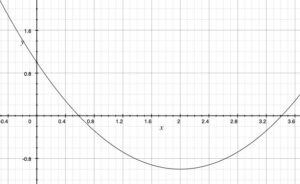In elementary algebra we learn how to solve ax2 + bx + c = 0 for roots r = r1, r2. But how about the inverse problem: given a real-valued r, find integer coefficients a, b and c such that r is a root of the corresponding quadratic equation.
A simple approximation can be found by setting b=0, so r2 = – c/a. By appropriately choosing large values of a and c, one can approximate the solution to this inverse problem to arbitrary accuracy.
Are there any other solutions (possibly taking advantage of b for a better approximation)?
Two families of algorithms are available: PSLQ [1-3] and LLL [4-5]. The underlying problem formulation behind these algorithms can be understood geometrically. For fixed x, L(a, b, c) = ax2 + bx + c is a linear function of (a, b, c), here considering a, b and c as real-valued. Thus, for such x, the equation L(a, b, c) = 0 defines a known plane in 3-D space. However, we seek a, b, c that are integers. The problem then is to find a lattice point (a, b, c) with a, b, c integers that is “near” to this plane (for example, close to the plane within tolerance τ, which means a 2-D thin “slab” of thickness 2τ surrounding this plane hits a lattice point). We would also prefer if the magnitude of a, b and c is “small” (e.g., bounded by a constant H).
Given this formulation, the PSLQ algorithm attempts to find an exact solution, and gives up if it can’t find one. The LLL algorithm on the other hand finds approximate solutions within a tolerance.
Python has the mpmath package, which contains mpmath.pslq for the PSLQ algorithm. The Python SciPy package has Matrix.LLL() for the LLL reduction.
A colleague of mine was previously submitting overnight runs to compute solutions using brute force search. More recently, using a Python code for the LLL algorithm, he is able to solve a large problem in seconds, with answers that exactly reproduce the brute force solution.
References
[1] Ferguson, Helaman R. P.; Bailey, David H. (1992). A Polynomial Time, Numerically Stable Integer Relation Algorithm. RNR Technical Report RNR-91-032, NASA Ames Research Center. URL: https://www.davidhbailey.com/dhbpapers/pslq.pdf
[2] Ferguson, Helaman R. P.; Bailey, David H.; Arno, Steve (1999). Analysis of PSLQ, an integer relation finding algorithm. Mathematics of Computation 68(225): 351–369. URL (AMS PDF): https://www.ams.org/mcom/1999-68-225/S0025-5718-99-00995-3/S0025-5718-99-00995-3.pdf
[3] Bailey, David H. (2020). PSLQ: An Algorithm to Discover Integer Relations. (Expository overview.) URL: https://www.davidhbailey.com/dhbpapers/pslq-comp-alg.pdf
[4] Lenstra, Arjen K.; Lenstra, Hendrik W., Jr.; Lovász, László (1982). Factoring Polynomials with Rational Coefficients. Mathematische Annalen 261: 515–534. DOI: https://doi.org/10.1007/BF01457454 (Springer page: https://link.springer.com/article/10.1007/BF01457454 (cf. https://www.math.ucdavis.edu/~deloera/MISC/LA-BIBLIO/trunk/Lovasz/LovaszLenstraLenstrafactor.pdf)
[5] Nguyen, Phong Q.; Vallée, Brigitte (eds.) (2010). The LLL Algorithm: Survey and Applications. Springer. URL: https://link.springer.com/book/10.1007/978-3-642-02295-1

